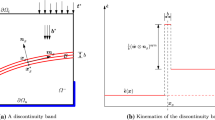Summary
Associative plasticity theories do not predict correctly the volumetric plastic strain, in the course of plastic deformation, in the case of materials where the position and conformation of the yield surface are functions of the prevailing hydrostatic stress. Non-associative theories have been proposed and used to correct this deficiency. Such theories, however, lead to other serious difficulties.
In this paper we establish clear criteria for the well-posedness of the initial, boundary/initial and boundary value problems when the plasticity theory is associative as well as non-associative. We further show cases where non-associativity leads to ill-posedness of these problems even when the material is not at failure. Specifically we demonstrate that the initial/boundary and boundary value problems either have no solution, or if they do, the solution is not unique.
We also show by specific examples that the banding condition, i.e., the vanishing of the determinant of the acoustic tensor, is tantamount (a) to loss of hyperbolicity of the equation of motion and (b) lack of existence or loss of uniqueness of the solution of the boundary value problem, in certain situations.
Finally, we show the existence of a fundamental criterion that governs the stability of infinitesimal as well as finite elastoplastic domains.
Similar content being viewed by others
References
Richmond, O., Spitzig, W. A.: Pressure dependence and dilatancy of plastic flow. XV International Congress of Theoretical and Applied Mechanics, Toronto, Canada 1980 (Rimrott, F. P. J., Tabbarok, B., eds.), pp. 377–386. Amsterdam: North-Holland 1980.
De Borst, R.: Non-linear analysis of frictional materials. Doctoral dissertation. Institut TNO voor Bouwmaterialen en Bouwconstructies, Delft, Holland 1986.
Maier, G., Hueckel, T.: Non-associated and coupled flow rules in rock-like materials. Int. J. Rock Mech. Min. Sci. Geom. Abstr.16, 77–92 (1979).
Vermeer, P. A.: Formulation and analysis of sand deformation problems. Doctoral dissertation. Delft University of Technology. Delft, Holland 1980.
Willam, K., Etse, G.: Failure diagnostics of non-associated elastoplastic material models. In: Developments in theoretical and applied mechanics Vol. XV (Hanagud, S. V., et al., eds.), pp. 887–897. XV Southeastern Conference of Applied Mechanics, Atlanta: Georgia, 1990 Atlanta: Georgia Inst. of Technology 1990.
Sandler, I. S.: The consequences of non-associated plasticity in dynamic problems. In: Constitutive laws for engineering materials: theory and applications Vol. I (Desai, C. S., et al., eds.), pp. 345–352. New York: Elsevier 1987.
Sandler, I. S.: Issues related to computational methods in continuum mechanics. In: Developments in theoretical and applied mechanics Vol. XV (Hnagud S. V., et al., eds.), pp. 898–907. XV Southeastern Conference of Applied Mechanics, Atlanta, Georgia 1990. Atlanta: Georgia Inst. of Technology 1990.
Hill, R.: A general theory of uniqueness and stability of elastic-plastic solids. J. Mech. Phys. Solids6, 236–249 (1958).
Drucker, D. C.: A more fundamental approach to plastic stress-strain relations Proceedings of the First National Congress of Applied Mechanics, ASME, 487–491 (1951).
Drucker, D. C.: A definition of a stable inelastic material. J. Appl. Mech.26, 101–106 (1959).
Mandel, J.: Condition de stabilité et postulat de Drucker. In: Rheology and soil mechanics (Kravtchenko, J., Sirieys, P. M., eds.), pp. 56–68. IUTAM Symposium, Grenoble, France 1964. Berlin Göttingen Heidelberg: Springer 1964.
Schaeffer, D. G.: Instability and ill-posedness in the deformation of granular materials. Int. J. Num. Anal. Methods Geomech.14, 253–278 (1990).
Ralston, A., Rabinowitz, P.: A First course in numerical analysis, 2nd ed. Tokyo: McGraw-Hill, 1978.
Courant, R., Hilbert, D.: Methods of mathematical physics, Vol. 1, New York: Interscience 1953.
Mroz, Z.: Non-associated flow laws in plasticty. J. Mech.2, 21–42 (1963).
Valanis, K. C.: On the uniqueness of solution of the initial value problem in softening materials. J. Appl. Mech.52, 649–653 (1985).
Hvorslev, M. J.: Über die Festigkeitseigenschaften gestörter bindiger Böden. In: Critical state soil mechanics (Schofield, A., Wroth, P., eds.), pp. 209–215. New York: McGraw-Hill 1968.
Casagrande, A.: Characteristics of cohesionless soils affecting the stability of slopes and earth fills. J. Boston Soc. Civil Eng.26, 257–276 (1936).
Poorooshab, H. B., Hobulec, I., Sherbourne, A. N.: Yielding and flow of sand in trixial compression: Part I. Can. Geotech. J.3, 179–190 (1966).
Lade, P. V.: The stress-strain and strength characteristics of cohesionless soils. Ph. D. Thesis. Berkley: University of California 1972.
Lade, P. V., Nelson, R. B., Yto, Y. M.: Non-associated flow and stability of granular materials. J. Eng. Mech. ASCE11, 1302–1318 (1987).
Peters, J. F.: Discussion of instability of granular materials with non-associated flow. J. Eng. Mech. ASCE117, 179–190 (1991).
Lade, P. V., Bopp, P. A., Peters, J. F.: Instability of dilating sand. Mech. Mat.16, 249–264 (1993).
Thomas, T. Y.: Plastic flow and fracture in solids. New York: Academic Press 1961.
Hill, R.: Acceleration waves in solids. J. Mech. Phys. Solids10, 1–16 (1962).
Rudnicki, J. M., Rice, J. R.: Conditions for the localization of deformation in pressure sensitive dilatant materials. J. Mech. Solids23, 371–394 (1975).
Vermeer, P. A.: A simple shear band analysis using compliances. In: Deformation and failure of granular materials (Vermeer, P. A., Luger, H. J., eds.), pp. 493–499. IUTAM Symposium, Delft, Holland 1982. Rotterdam: Balkema 1982.
Molenkamp, F.: Comparisons of frictional material models with respect to shear band initiation. Geotechnique35, 127–142 (1985).
Valanis, K. C.: Banding and stability in plasticmaterials. Acta Mech.79, 113–141 (1989).
Author information
Authors and Affiliations
Rights and permissions
About this article
Cite this article
Valanis, K.C., Peters, J.F. Ill-posedness of the initial and boundary value problems in non-associative plasticity. Acta Mechanica 114, 1–25 (1996). https://doi.org/10.1007/BF01170392
Received:
Issue Date:
DOI: https://doi.org/10.1007/BF01170392



